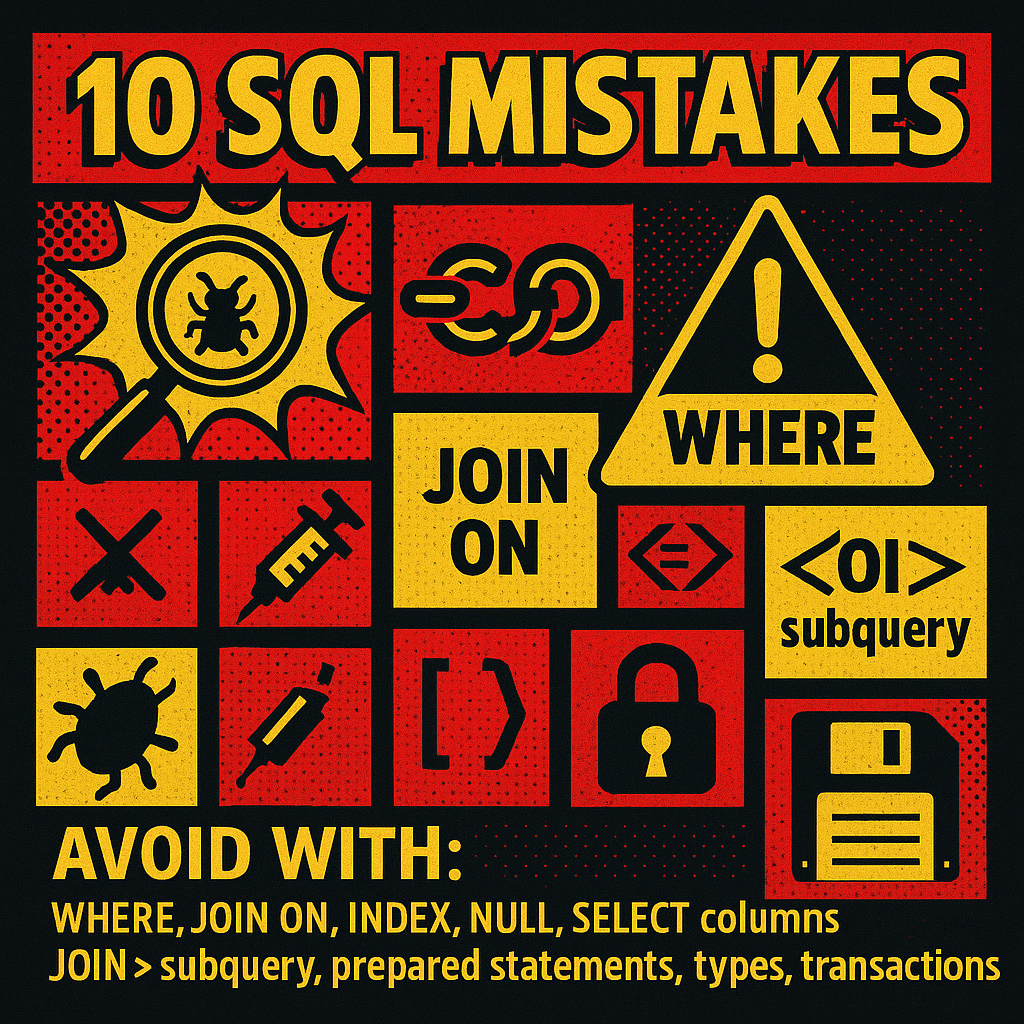Structured Query Language (SQL) is a powerful tool for working with relational databases. However, even experienced developers can make mistakes that lead to incorrect results, performance issues, or security vulnerabilities. In this article, we’ll explore 10 common SQL mistakes and provide guidance on how to avoid them, along with examples.
Table of Contents
- Missing or Incorrect WHERE Clause
- Improper JOIN Conditions
- Ignoring Indexes
- Not Handling NULL Values
- Using SELECT
- Unnecessary Subqueries
- Lack of Data Validation
- Not Considering Data Types
- Not Using Transactions
- Lack of Regular Backups
1. Missing or Incorrect WHERE Clause
Forgetting to include a WHERE clause or writing an incorrect condition can result in retrieving incorrect data or updating/deleting unintended rows. Always double-check your conditions to ensure they accurately filter the desired data. For example:
- ### Incorrect: missing WHERE clause
SELECT * FROM orders;- ### Correct: applying a proper WHERE clause
SELECT * FROM orders WHERE status = 'completed';2. Improper JOIN Conditions
Incorrect join conditions can lead to Cartesian products, where the result set contains more rows than expected. Be cautious when joining tables and ensure that you specify the correct columns to establish relationships. For instance:
- ### Incorrect: missing join condition
SELECT *
FROM customers
JOIN orders; -- Missing ON condition- ### Correct: specifying the join condition
SELECT *
FROM customers
JOIN orders ON customers.id = orders.customer_id;3. Ignoring Indexes
Neglecting to utilize appropriate indexes can result in slow query performance, especially when working with large tables. Analyze your query execution plans and consider adding indexes on columns used frequently in WHERE, JOIN, and ORDER BY clauses. Here’s an example:
- ### Incorrect: not using an index
SELECT *
FROM users
WHERE username = 'john';- ### Correct: utilizing an index
CREATE INDEX idx_username ON users (username);
SELECT *
FROM users
WHERE username = 'john';4. Not Handling NULL Values
Ignoring NULL values or treating them incorrectly can lead to unexpected results or data inconsistencies. Always consider NULL values in your queries and use appropriate functions like IS NULL or IS NOT NULL. For instance:
- ### Incorrect: not accounting for NULL values
SELECT *
FROM users
WHERE age > 30;- ### Correct: handling NULL values
SELECT *
FROM users
WHERE age > 30 OR age IS NULL;5. Using SELECT
Using SELECT can impact performance and make it harder to maintain your code, especially as the schema evolves. Instead, explicitly specify the columns you need to retrieve. Here’s an example:
- ### Incorrect: selecting all columns
SELECT *
FROM products;- ### Correct: selecting specific columns
SELECT id, name, price
FROM products;6. Unnecessary Subqueries
Using subqueries when they are unnecessary can lead to inefficient queries. Whenever possible, consider using JOINs or other alternatives for better performance. Here’s an example:
- ### Incorrect: using a subquery unnecessarily
SELECT *
FROM products
WHERE category_id IN (SELECT id FROM categories WHERE name = 'Electronics');- ### Correct: using a JOIN instead
SELECT products.*
FROM products
JOIN categories ON products.category_id = categories.id
WHERE categories.name = 'Electronics';7. Lack of Data Validation
Failing to validate input data can expose your database to SQL injection attacks. Always use parameterized queries or prepared statements to prevent malicious actions. Consider the following:
- ### Incorrect: vulnerable to SQL injection
$sql = "SELECT * FROM users WHERE username = '" . $username . "'";- ### Correct: using parameterized queries
$stmt = $pdo->prepare("SELECT * FROM users WHERE username = ?");
$stmt->execute([$username]);8. Not Considering Data Types
Incorrectly comparing or manipulating data of different types can lead to unexpected behavior or errors. Pay attention to data types and use appropriate casting or conversion functions when necessary. For example:
- ### Incorrect: comparing different data types
SELECT *
FROM users
WHERE age = '25';- ### Correct: comparing matching data types
SELECT *
FROM users
WHERE age = 25;9. Not Using Transactions
Neglecting to use transactions when performing multiple related operations can result in data inconsistencies or partial updates in case of failures. Wrap your operations in a transaction to ensure atomicity. Consider this example:
- ### Incorrect: not using a transaction
UPDATE users SET balance = balance - 100 WHERE id = 1;
INSERT INTO transactions (user_id, amount) VALUES (1, 100);- ### Correct: using a transaction
START TRANSACTION;
UPDATE users SET balance = balance - 100 WHERE id = 1;
INSERT INTO transactions (user_id, amount) VALUES (1, 100);
COMMIT;10. Lack of Regular Backups
Failing to regularly backup your databases can lead to data loss in case of hardware failures, software errors, or human mistakes. Establish a backup routine to ensure data safety. Consult your database documentation for backup strategies.
Conclusion
By avoiding these common SQL mistakes, you can write more reliable and efficient database queries. Remember to double-check your conditions, utilize proper join conditions and indexes, handle NULL values appropriately, and validate input data to enhance security. Continuously learning and improving your SQL skills will help you become a proficient and confident SQL developer or data analyst. Happy querying!

Leave a Reply